The Immigrant Processing At Ellis Island
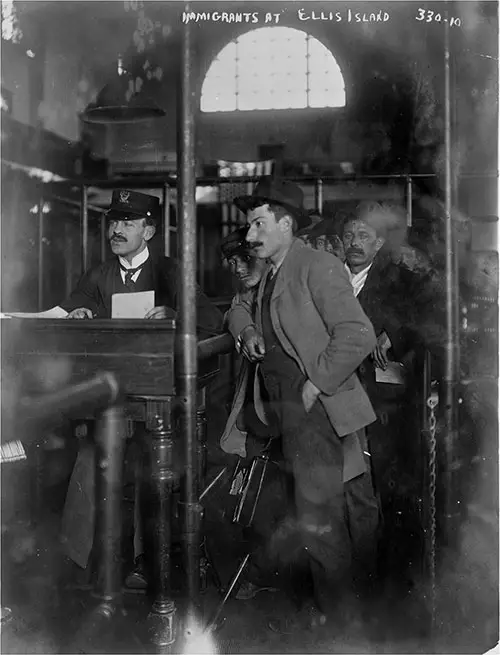
Immigrant at Registration Desk at Ellis Island ca 1910s. Bain News Service. Photograph shows a man waiting, with others in queue behind him, at the registration desk in the immigration station on Ellis Island; an immigration official is seated at the desk. Library of Congress # 97501640. GGA Image ID # 148505c990
Immigrants Respond to Questions at the Inspector's Desk at Ellis Island
You may think you can gain some idea about the arrivals at Ellis Island and of the Immigrant, but you never can. You must get a permit, as we did, from the authorities and see for yourself the "human stream that pours from the steerage of every steamship that docks there, into that huge reservoir, Ellis Island."
You should have seen those people land as I did. The noise was simply indescribable. Families tried to keep together, babies were crying, every other person seemed to be speaking a different language and pandemonium reigned supreme.
These masses of people lugging all sorts and conditions of baggage were hurried down the long narrow gang- (Tableau z) way to the pier. All were sworn at for not moving faster, many were punched with a stick, and some treatment given by the stewards fairly made my blood boil. but I was powerless to prevent them or help.
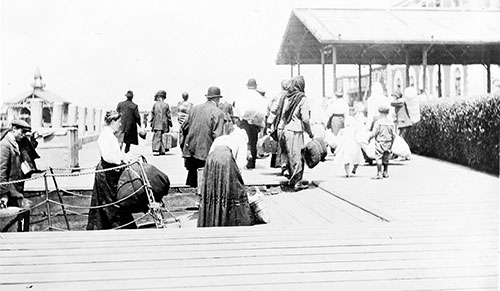
Immigrants On the Docks at Ellis Island
After they reached the pier the confusion was worse than before, if possible. Many thought their baggage had been stolen; mothers were sure their children had been kidnapped or lost—poor souls, as if anyone would want to steal them 1—while everyone was tired and hungry, having had no food since early breakfast.
Ellis Island was the next place, and as they climbed the broad stairs in the great building, an officer familiar with many languages shouted, first in one tongue then in another, "Get your health tickets ready." And where do you suppose they carried them? Why, in their mouths to be sure, for their hands were full of children or baggage.
(Tableau 3.) At the head of the long pair of stairs, a uniformed officer met them, took their tickets and stamped them with the Ellis Island stamp.
The next officer encountered was a keen eyed doctor, who seemed with one sharp glance to be able to determine what they had, or what they ought to have that they did not have.
He was on the lookout for any signs of disease or deformity, and when anyone was found, the unfortunate possessor of them he received a white chalk mark on his coat or sleeve. That meant the "detention pen" where he must wait for a more rigid examination.
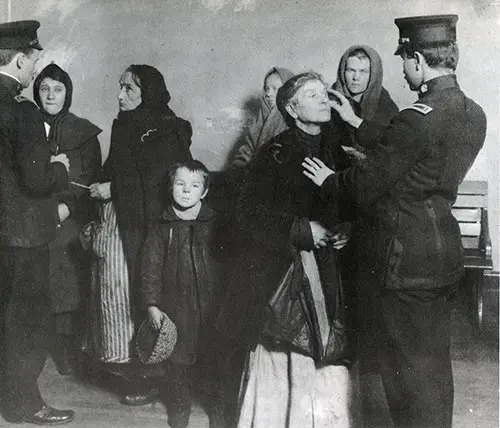
Doctor Examine the Eyes of a Female Immigrant at Ellis Island
(Tableau 4.) Officer No. 4 had a towel hanging beside him, a small instrument in his hand, and a basin of disinfectants behind him. Before the poor immigrant suspected what was coming or could say "Jack Robinson" he applied the instrument to his eye turning up the lid and quickly shutting it down again. He then repeated the operation on the other eye.
He also was looking for trouble, and if any serious disease was discovered, back the poor man would have to go to his native country.
Officer No. 5, and the last one to be faced was a woman, and it was her place to discover suspicious characters and either send them to the detention rooms or special inquiry hoards.
And why was a woman selected for this important task do you ask? Why, Elizabeth Rollins, I'm surprised that you should ask such a question! Woman's intuition of course.
The entrance ordeal was not quite over, however, but the poor immigrants were allowed to rest for a little while in curiously railed off compartments marked with large letters, A. 13. C. D., etc.
I forgot to tell you that before these people embark for this country, each one is given a card with a number and letter on it. Thus he is known as 25 B. throughout the voyage.
This card must always be kept in sight as a means of identification. (Tableau 5.) After a short rest officer No. 0 came along with a sheet of paper in his hand marked B.
Then everyone in the "B" Compartment had to file out and be asked a lot of questions. If the answers agreed with those given before to similar questions, they were ticketed with an 0. K. and an R., which meant they were bound for a railroad station.
A lame man received a ticket marked "S. I." which meant he had to go before a board of Special Inquiry; -on another read "L. P. C.," "liable to become a public charge." Of course, that meant deportation.
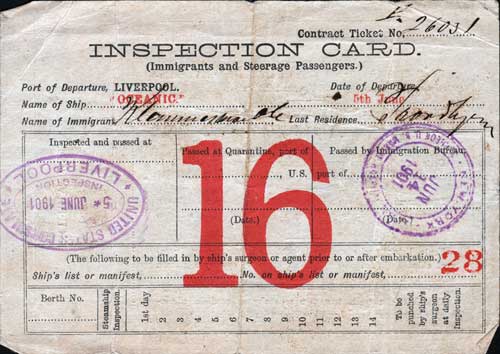
Inspection Card for Immigrants and Steerage Passengers on the RMS Oceanic, Departing Liverpool for New York on 5 June 1901 and Arriving in New York Ellis ISland on 14 June 1901. GGA Image ID # 1f1d2c323c
You would be surprised to see the ways in which these people try to trick Uncle Sam. "Diseased eyes have been doctored up for the occasion; lame persons have been trained to avoid the fatal limp during that walk between the two Surgeons; a man will hang his overcoat over a useless arm, and one method or another is used to enable them to get into this country."
I just want to tell you of two men who came before the inspector and how they were treated. One was a bookkeeper whose father had given him money and he was coming over here to make his fortune.
"The inspector was not satisfied, and he was turned over to the 'S. I.' Board. But his papers, money, and statements were clear and he was admitted; they gave him the benefit of the doubt as they always do. But next in line came a well built stocky Pole, with nothing in the world but a carpet-bag, a few bundles, and a small showing of money.
Ambition was written all over his face, and he was admitted. 'Now,' said the recorder, to Uncle Bob, pausing for a moment, 'see the difference between these two gents. The first duffer will look around for a job, spend time and money to get something to suit him, and keep his job for a short time; then he will give it up, run through his money, borrow from his friends, and then give them all the cold hand.
He won't wear well, and his dad knew it when he sent him over, but he was glad to get rid of him. So lots of them are. Now, look at the difference between him and that Pole. He knows nothing but work. Look at his eyes, mild but good.
He has been brought up next to mother earth; turn him loose from the train when he reaches his destination and he will dig. He won't hang around looking for a job, but he will till the soil, and before you or I know it he will have crops, and that is what he will live on.
He comes from a hard country, is tough, and when you and I are going around shivering in an overcoat, he will be going around in his shirt sleeves. That is the stuff we want here, not the first kind, with flabby hands and sapped vitality.' "
Sure enough, the inspector was right. Uncle Bob saw him a few months later and he said the bookkeeper finally fell into the hands of the police and was sent back to his home.
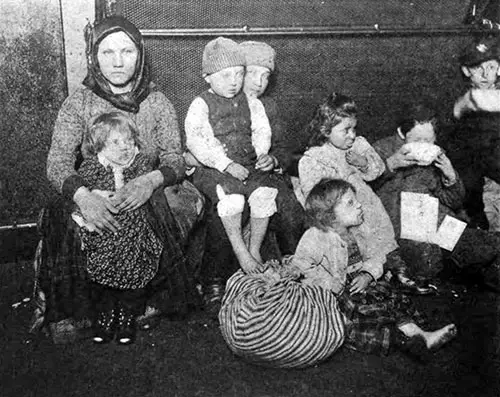
Immigrant Family Detained at Ellis Island
"The inspectors are wise in showing partiality to the men who have plenty of days work in them, even if they have less money."
Well, do you know I became so interested in watching these people that I felt sorry to see the last one leave.
Hawkins, Jessie Kemp, "Winifred Adams' Visit to New York and its Outcome," in the Home Missionary, Volume LXXXII, No. 1, April 1908
